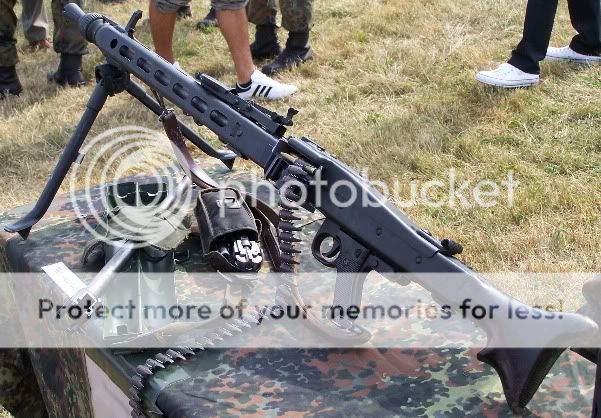
Weapon Name- Rheinmetall MG 3
Type- Machine Gun
Damage- 3L
Range- 325/750/1500
Ammunition- 500 per 27.5
Strength Level- 4
Strength Level for firing- 4 for burst, 4 for medium burst, 4 for extended burst
Special Consideration- Re-roll all success.
Round Type- 7.62mm x 51mm NATO
Over-all length- 1,225 mm (48.2 in)
Barrel length- 565 mm (22.2 in)
Weight- 11.5 kg (25.35 lb)
Rate of Fire- 1000-1300 rounds per minute
Feed Mechanism- Belt Fed; although the belt can be held in a drum
Round Capacity- 50, 100+ linked
Accuracy- 2 MOA
Accessories- Picanty Rail
Quick switch firing mechanism- N/A
Scope/Sights- Picanty Rail
Muzzle Velocity- 820-840 m/s
Firing System- The MG 3 is an automatic, air-cooled, belt-fed short recoil-operated
Miscellaneous/electronic information- The weapon is essentially one of the fastest firing machine guns in existence, based off of the MG42 developed in WWII.
Basic Information
The MG 3 is an automatic, air-cooled, belt-fed short recoil-operated firearm. It features a roller locked bolt mechanism that consists of the bolt head, a pair of rollers, the striker sleeve, bolt body and return spring. The bolt is locked securely by a wedge-shaped striker sleeve, which forces two cylindrical rollers contained in the bolt head outward, and into corresponding recesses in the extension of the breech of the barrel. On firing, both the barrel and barrel extension recoil to the rear. The resulting impact (much like a Newton's cradle) moves the carrier to the rear withdrawing the wedge and both rollers as they are cammed inward and out of their sockets by fixed cams, unlocking the bolt head. The bolt carrier and bolt then continue to the rear together guided by fixed guides while the barrel and barrel extension return to battery. Upon return of the bolt forward, the impact of the rollers against the camming surfaces on the breech carry the rollers from their seats, and, together with the surfaces on the striker sleeve, force the rollers outward, locking the bolt head into the barrel extension and ensuring a complete lock. The bolt also houses a spring-loaded casing extractor and ejector. Ejection is carried out when the ejector strikes the buffer head, sending a push forward through the ejector bar, which hits the ejector pin. This pin pushes the top of the base of the cartridge, which is still held by the extractor at the base, causing the empty casing to rotate and eject downward through the ejection chute.

